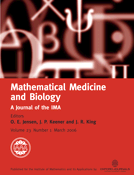-
Views
-
Cite
Cite
Alexander I. Oleinick, Christian Amatore, Manon Guille, Stephane Arbault, Oleksiy V. Klymenko, Irina Svir, Modelling release of nitric oxide in a slice of rat's brain: describing stimulated functional hyperemia with diffusion-reaction equations, Mathematical Medicine and Biology: A Journal of the IMA, Volume 23, Issue 1, March 2006, Pages 27–44, https://doi.org/10.1093/imammb/dql001
Close - Share Icon Share
Abstract
The physicochemical process of nitric oxide (NO°) release from an active neuron is modelled based on the results obtained experimentally in independent series of experiments reported elsewhere in which the NO° release elicited by patch-clamping a single neuron (stellate neuron from cerebellum area) is monitored by an ultramicroelectrode introduced into a slice of living rat's brain. This process is believed to be central to brain behaviour by coupling neuronal activity with the blood supply to active areas of the living brain through precise control of NO°-mediated dilatation of blood capillary vessels. This work, based on the conformal mapping approach initially proposed in a previous work, aims to model the overall physicochemical and diffusional processes giving rise to the release of NO° by a neuron and during its collection at an electrode sensor. Fitting simulated currents to experimental ones published previously yields indeed the gross kinetic information which represents the overall neuron activation and defines the instant value of the concentration of NO° at the neuron surface. This allows reconstructing the NO° fluxes around the neuron body as they would have been in the absence of the electrode sensor. This permits one to appreciate how far NO° is released by the neuron at concentrations which greatly exceed their basal values. The success of this procedure is exemplified using a set of three experimental data reported elsewhere.





